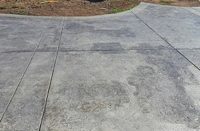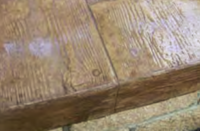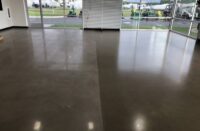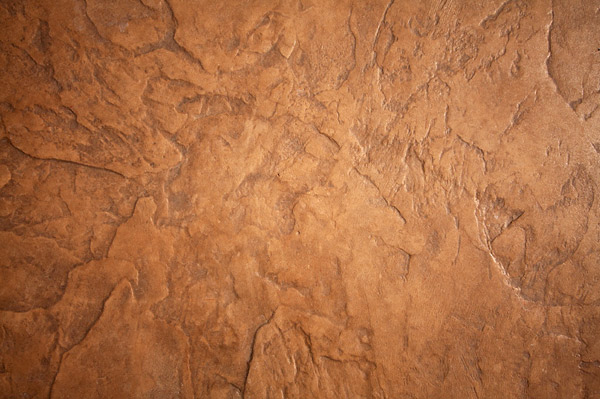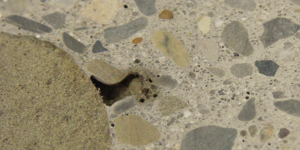It’s no secret that most people think sealers are the Achilles’ heel of decorative concrete. You can do nearly everything perfectly while installing your concrete masterpiece only to have something like a sealer decimate all your good efforts. That’s the bad news. Lucky for us, there’s some good news, too. It’s well beyond time to rethink how exterior decorative concrete is sealed and then move forward with the peace of mind knowing our industry is on the verge of a major breakthrough.
Let’s agree that the majority of exterior decorative work, if sealed, is sealed with a solvent-based acrylic that leaves a glossy film on the surface. This process usually leaves the concrete looking shiny and glossy, and then over the course of weeks or months the coating acquires a more satin sheen. The vibrant shine will nearly always last long enough for checks to clear but, typically, soon after that adverse issues often arise. The situation is frequently diagnosed as a sealer applied too thickly to allow moisture to pass beyond the concrete surface, thereby creating a white or cloudy appearance just beneath the sealer. At this point the sealer is in the early stage of failure. The prognosis is often stripping, which is no easy feat, and then reapplying the same old sealer that didn’t work right in the first place.
In my opinion, you never stood that good of a chance for long-term success regardless of how the sealer was applied. But things are changing for the better!
Try it, you’ll like it
I’ve personally been searching for sealer solutions since the first time I installed stamped concrete many years ago. Recently, I’ve become optimistic that the problem could be solved. What if a sealer could be formulated using a low-build, low-sheen product that allows concrete to “breathe” beyond the sealer membrane and let moisture escape? What if the same sealer is thin enough that it’s not only breathable but it also won’t white out or peel? The good news is that there is a hybrid sealer in production that’s VOC compliant and readily available in every state across the United States.
Most of you know I wouldn’t be wasting good space touting a sealer without testing it. I first tried it by resealing a small patio at my home. The sealer dried in moments and left a subtle, but not glossy, sheen. It’s worth noting the hybrid sealer has less chemical odor compared to typical film-type sealers I’ve used in the past.
After feeling sealer confident, I next applied two coats over 1,000 square feet of newly stamped concrete that had cured for 30 days. To say the sealer is user friendly is an understatement. The sealer comes from the can ready to brush, roll or spray with no dilution needed. We cut edges with a brush just prior to spraying the field, noticing firsthand how easily the material applied to the clean concrete and admiring the low-build consistency of the product.
The hybrid sealer sprays nicely but thinner than what most of us are used to. The first pass, or coat, will be evident but not glossy like most traditional film-type sealers. The first coat dried in minutes, allowing me to retrace my steps by applying a second coat evenly over the stamped concrete surface. I noticed my sprayer’s Viton-protected seals couldn’t hold the product from slightly dripping but it left no visible drip marks on the sealed surface. Both sealer coats combined factored into around 200 square feet per gallon usage. I paid slightly less than $40 per gallon for the sealer, which I bought in 5-gallon containers.
My customers loved the end result of two coats of this sealer. Personally, I noticed the surface was less glossy and more slip-resistant than what was produced with sealers I’ve used in the past.
Thin is in
Bob Chatterton with Trinic has used reason and common sense to develop this sealer, called Stamp Shield. I’m told Stamp Shield originated by necessity as well as encouragement from a decorative concrete contractor at his wit’s end over sealer failure. Some of you can surely relate. The folks at Trinic believe the key is formulating a breathable sealer that achieves long-term success by utilizing a low-build, low-sheen sealer applied in thin layers.
Trinic’s Stamp Shield description claims the sealer will not white out or peel, will waterproof in 10 minutes and is compatible with most solvent reseals. The solvent catalyst is acetone, which means it is VOC compliant across the U.S. — even in California where xylene regulations have taken the bite out of many sealers and coatings.
Feel free to let me know your take on this or any other sealer type you feel will enhance our decorative concrete industry. Even with great advancements, we still have room for improvement and such improvement will make our industry stronger for all.
Editor’s note: The opinion expressed in this article is that of the author. The mention of a specific product does not imply endorsement by Professional Trade Publications or Concrete Decor magazine.
